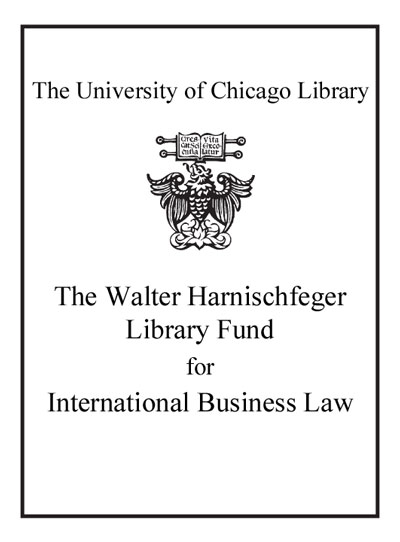Edirectives : guide to European Union law on E-commerce : commentary on the directives on distance selling, electronic signatures, electronic commerce, copyright in the information society, and data protection /
Saved in:
| Imprint: | The Hague ; New York : Kluwer Law International, c2002. |
|---|---|
| Description: | xii, 203 p. ; 25 cm. |
| Language: | English |
| Series: | Law and electronic commerce ; v. 14 |
| Subject: | |
| Format: | Print Book |
| URL for this record: | http://pi.lib.uchicago.edu/1001/cat/bib/4653380 |
Table of Contents:
- Preface
- Summary of contents
- Detailed table of contents
- Chapter 1. Introduction
- 1.1. What is e-commerce?
- 1.2. Types of electronic commerce
- 1.3. The EU and e-commerce regulation
- 1.3.1. E-money and financial services
- 1.3.2. E-Tax
- 1.3.3. Jurisdiction
- 1.3.4. Miscellany
- 1.4. Structure of the book
- Chapter 2. Directive 97/7/EC on the protection of consumers in respect of distance contracts
- 2.1. Introduction
- 2.2. Article 2--Definitions
- 2.3. Article 3--Exemptions
- 2.4. Articles 4 and 5--Transparency rights of the consumer
- 2.4.1. The reason for the transparency provisions
- 2.4.2. The point at which the information must be given
- 2.4.3. The manner in which the information must be given
- 2.4.4. Prior information-information to be given at the outset
- 2.4.5. Information which must be confirmed
- 2.5. Article 6--Right of withdrawal
- 2.6. Article 7--Performance
- 2.7. Article 8--Payment by card
- 2.8. Articles 9 and 10--Unsolicited supply and contact
- 2.9. Articles 11, 12 and 17--Access to justice, enforcement and consumer redress
- 2.9.1. Enforcement
- 2.9.2. Standing for consumer organisations?
- 2.9.3. Access to justice, out of court settlement and EEJ-net
- 2.9.4. Burden of proof
- 2.9.5. Contracting-out
- 2.10. Articles 13 and 14--Lex specialis and higher consumer protection standards
- 2.11. Articles 15 and 18--Entry into force and implementation deadline
- 2.12. Concluding remarks
- Chapter 3. Directive 1999/93/EC on a Community framework for electronic signatures
- 3.1. Introduction
- 3.1.1. Terminology
- 3.1.2. Crytography policy
- 3.1.3. First national legislative initiatives
- 3.1.4. The preparation of the Directive
- 3.1.5. Standardisation
- 3.2. Article 1--Scope of the Directive
- 3.3. Article 2--Definitions
- 3.3.1. (Advanced) electronic signature
- 3.3.2. Certificates and certification services
- 3.4. The certification services market--Articles 3(1 -3, 7) and 4(1)
- 3.4.1. Free circulation of certification services
- 3.4.2. No prior authorisation
- 3.4.3. Voluntary accreditation
- 3.4.4. Supervision
- 3.5. Electronic signature products--Articles 3(4-6) and 4(2)
- 3.5.1. Free circulation of electronic signature products
- 3.5.2. Secure signature-creation devices
- 3.5.3. Secure signature-verification devices
- 3.6. Article 5--Legal effects of electronic signatures
- 3.7. Article 6--Liability
- 3.7.1. Qualified certificate
- 3.7.2. Issued to the public
- 3.7.3. 'Guaranteed to the public'
- 3.7.4. Claimant ('relying party')
- 3.7.5. Liability causes
- 3.7.6. Reasonable reliance
- 3.7.7. Absence of negligence
- 3.7.8. Limitation of liability
- 3.8. Articles 7-15--Other provisions
- Chapter 4. Directive 2000/31/EC on certain legal aspects of information society services, in particular electronic commerce, in the Internal Market
- 4.1. Introduction
- 4.2. General provisions
- 4.2.1. Article 1--Objective and scope
- 4.2.2. Article 2--Definitions
- 4.2.3. Article 3--Internal market
- 4.3. Establishment and information requirements
- 4.3.1. Article 4--Principle excluding prior authorisation
- 4.3.2. Article 5--General information to be provided
- 4.4. Commercial communications
- 4.4.1. Article 6--Information to be provided
- 4.4.2. Article 7--Unsolicited commercial communications
- 4.4.3. Article 8--Regulated professions
- 4.5. Online contracts
- 4.5.1. Article 9--Treatment of contracts
- 4.5.2. Article 10--Information to be provided
- 4.5.3. Article 11--Placing of the order
- 4.6. Liability of intermediary service providers
- 4.6.1. Article 12--'Mere conduit'
- 4.6.2. Article 13--'Caching'
- 4.6.3. Article 14--Hosting
- 4.6.4. Article 15--No general obligation to monitor
- 4.7. Codes of conduct and dispute settlement
- 4.7.1. Article 16--Codes of conduct
- 4.7.2. Article 17--Out-of-court dispute settlements
- 4.7.3. Article 18--Court actions
- 4.8. Cooperation and sanctions
- 4.8.1. Article 19--Cooperation
- 4.8.2. Article 20--Sanctions
- 4.9. Articles 21-24--Final provisions
- 4.10. Concluding remarks
- Chapter 5. Directive 2001/29/EC on the harmonisation of certain aspects of copyright and related rights in the information society
- 5.1. Article 1--Scope
- 5.1.1. Objective
- 5.1.2. Scope
- 5.2. Article 2--Reproduction right
- 5.3. Article 3--Communication to the public
- 5.4. Article 4--Distribution right
- 5.5. Article 5--Exceptions and limitations
- 5.5.1. General observations
- 5.5.2. Specific commentaries
- 5.5.2.1. Exceptions to reproduction right
- 5.5.2.2. Exceptions to different rights
- 5.5.2.3. Right of distribution
- 5.5.3. Valuation
- 5.6. Article 6--Technological measures
- 5.7. Article 7--Rights-management information
- 5.8. Articles 8-15--Common provisions
- 5.9. Concluding observations
- Chapter 6. Data protection and e-commerce
- 6.1. Data protection and data protection instruments
- 6.2. Directive 95/46/EC
- 6.2.1. History and Implementation
- 6.2.2. Scope
- 6.2.3. Elaboration of the data protection principles
- 6.2.4. Other safeguards
- 6.3. The Telecommunications directive 97/66/EC
- 6.3.1. History and implementation
- 6.3.2. Scope
- 6.3.3. Relation to Directive 95/46/EC
- 6.3.4. The obligations under Directive 97/66/EC
- 6.4. Proposal for amendment of Directive 97/66/EC
- 6.4.1. History and background of the proposal
- 6.4.2. New definitions
- 6.4.3. New important elements in the Directive
- 6.4.4. Conclusion
- 6.5. Some specific aspects of data protection in e-commerce
- 6.5.1. Particular Privacy risks in e-commerce
- 6.5.2. Traffic data
- 6.5.3. Cookies
- 6.5.4. E-mail directories
- 6.5.5. Spam (unsolicited communications)
- 6.5.6. E-mail systems
- 6.5.7. Remedies: Anonymity/pseudonymity?
- 6.6. Concluding observations
- Appendix 1. Directive 97/7/EC
- Appendix 2. Directive 1999/93/EC
- Appendix 3. Directive 2000/31/EC
- Appendix 4. Directive 2000/29/EC
- The authors
- Index

